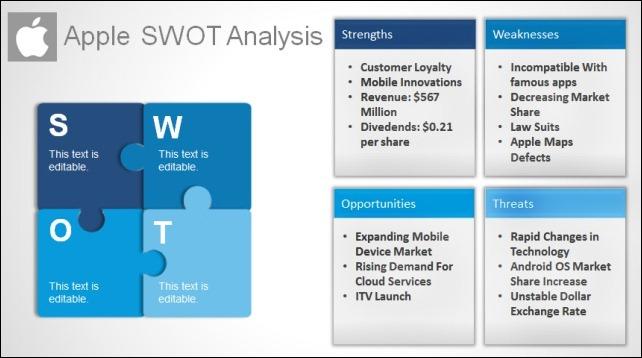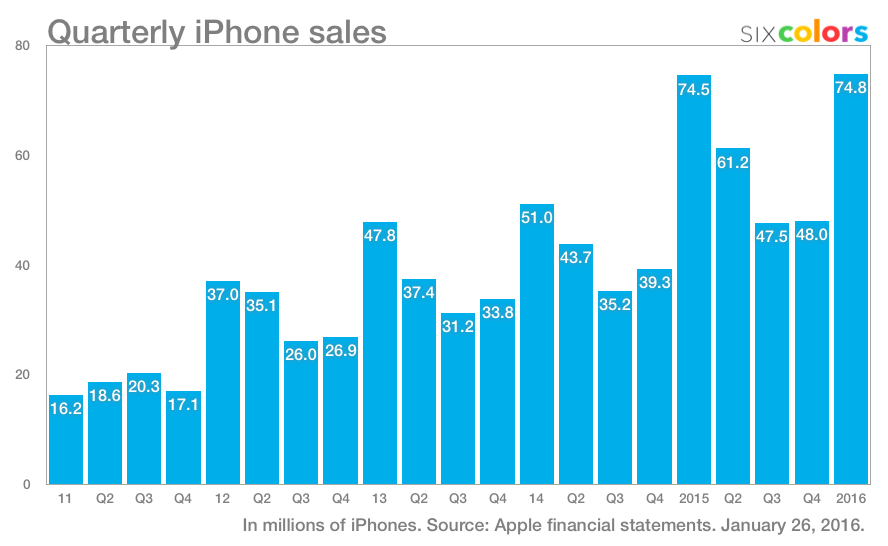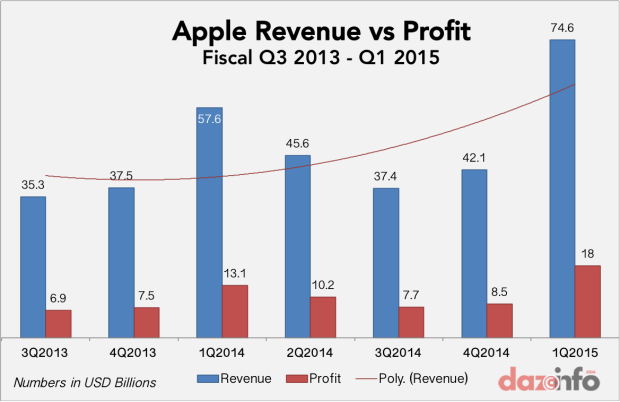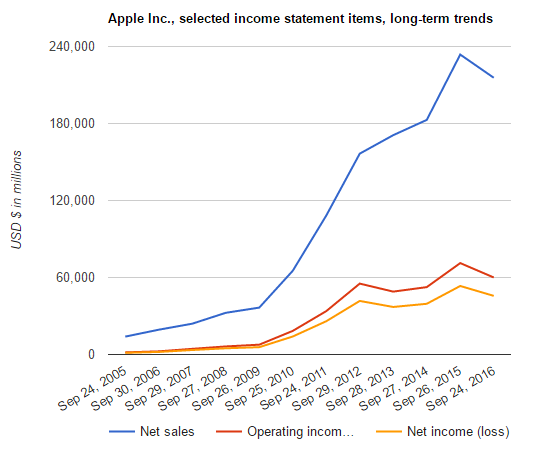Introduction
The Apple Company is one of the leading manufacturers and distributors of consumer electronics globally. The firm is renowned for its distinguishable product design and longstanding business strategy that has maintained its growth. Its products include wearable devices, smartphones, personal computers, and tablets. Apple Inc. also develops software products such as online music and book stores, web browsers, productivity suites, and operating systems (OS). The company has established numerous selling outlets around the world, which help in the distribution of its products. Its superiority in the development and fabrication of exclusive consumer electronics has ensured a longstanding public image, which has helped in the realization of increased sales.
Nonetheless, the Apple Company has experienced many challenges in the management of its operations after the death of Steve Jobs in 2011. Ever since it has struggled to maintain its success in the consumer electronics industry owing to increased competitiveness and dwindled innovativeness in the firm. Indeed, the leadership of the new CEO, Tim Cook, has been questioned over its progression in the company’s time-honored innovativeness and product vision.
The firm sustained a remarkable growth between 2010 and 2014 despite the worsening economic situation at the time. However, there has been reduced performance since 2015 due to several challenges that arose from the leadership of Tim Cook. Research has shown that the new company leader does not possess the inventive spirit of Steve Jobs. As a result, the CEO and his senior managers are fighting to maintain the firm’s legacy and position in the consumer electronics industry in vain. This essay provides insight into the Apple Company’s strategic issue in an attempt to recommend various resolutions that can be adopted to unravel its present-day challenges.
Strategic Issue
The company’s greatest goal is to adopt brilliant strategies that focus on developing an innovative digital lifestyle hub for its diverse consumers. Positioning such strategies in a market characterized by dynamic trends was one of the primary goals of Steve Jobs (former CEO of Apple Inc.). Various studies have revealed that the firm’s brilliant strategies have helped in the development of its product value and brand image over the years.
Nevertheless, since the death of its former CEO, the company has been struggling to sustain its performance in a multidimensional and competitive business setting. To begin with, the Apple Company has adopted a centric approach that focuses on the home market in the United States. This strategy has resulted in the seizure of 40% of the US market, which generates about 60% of its revenue. In comparison, other companies including Samsung and Nokia have established numerous selling and distribution outlets worldwide that have led to the generation of over 90% revenue from overseas markets.
Recent market research on the Apple Company revealed that it continued to lose its international market share in 2015, an indication that its US-centric model does not fit well in an industry that is characterized by increased market forces. Along these lines, it is undeniable that the Apple Company is facing strong competition from other industry players such as Google, Samsung, LG, Dell, HP, Motorola, and Sony among others. These companies have come up with substitute products that have led to decreased sales volume in Apple Inc.’s iPhone and iPad. Technological advancement has also resulted in the availability of cheaper consumer electronics with increased performance and features that are more desirable.
External Analysis
Porter’s Five Forces model is a theoretical concept that uses five market aspects to describe the nature of competitive forces that exist within a given industry. In this analysis, this conceptual framework is used to assess the impact of market forces and their influence on the sustainability of the Apple Company’s growth.
Competitive Rivalry
The Apple Company conducts its operations within a market that is characterized by aggressive competitive forces in many aspects including product features and adaptability to varying technological needs. This element of Porter’s Five Forces model provides an appropriate framework for the analysis of the level of competitiveness in the market. The case study reveals that the rivalry within the industry in which the Apple Company operates is hinged on external factors such as low switching costs and amplified aggressiveness amongst competitor companies. Rival companies that are competing with Apple Inc. in the consumer electronics business include Google, Samsung, LG, Dell, HP, Motorola, and Sony among others.
Recent market research revealed that the switching cost for the Apple Company is rather low. As a result, consumers can easily shift to purchase their preferred brands from competitor companies. This scenario is evident in the reduced sales volume in the company’s iPhones and iPads.
Bargaining Power of Suppliers
The bargaining power for suppliers is low. The Apple Company has a vast network of suppliers that stretches to Mexico, Japan, China, Brazil, and Taiwan among other overseas countries. This huge number of dealers has significantly limited the firm’s bargaining power. Since the business environment has become more competitive, the firm is has chosen to collaborate with its suppliers rather than pressuring them using high bargaining power.
Collaboration is paramount to ensuring competence, and agility of the supply chain, especially in the consumer electronics industry. The impact of suppliers on product demand cannot be underestimated in the attainment of an improved sales volume. Recent research revealed that the bargaining power for Apple Inc.’s suppliers was low due to their high number along with the increased supply of its products. Although the company has less than 200 component suppliers for its products, there are many more in different parts of the globe.
This arrangement significantly reduces the power of individual sellers; hence, they hardly ever impose their demands on the firm. Along these lines, the Apple Company does not have to concentrate on the bargaining power of suppliers in the making of decisions on strategies that are meant for the improvement of its position in the consumer electronics industry.
Bargaining Power of Buyers
The bargaining power of buyers is high. Owing to the ever-increasing competition in the consumer electronics industry, consumers are endowed with a plethora of choices. As a result, the buyers have considerably high bargaining power against the sellers. Some customers who have proved loyal to the Apple Company brands may not be ready to switch to the products offered by rival companies. Nonetheless, this number of consumers is relatively small in the market place.
A majority of customers, especially in emerging markets, are considered cost-conscious. Consequently, they would rather prefer purchasing cheaper consumer electronics offered by competitor companies since the prices of the products offered by Apple Inc. are relatively high. For instance, many of the consumer electronics produced and distributed by Samsung are relatively cheaper as compared to the ones it offers. As a result, cost-conscious customers rather prefer obtaining good quality products at cheaper prices.
Consumer trends have a significant influence on the realization of success in the Apple Company. Based on the case study, the bargaining power of the buyers is controlled by the unlimited choice of products in the market; hence, they can easily switch to rival companies that offer relatively reduced prices for quality brands. Therefore, the Apple Company should improve its services per consumer to sustain its time-honored brand loyalty with a view of increasing the sales volume of its products.
The threat of New Entrants
The threat of new entrants is considered high. By the virtue of the recent market entry by some companies such as Lenovo, Huawei, and Xiaomi, it can be attested that the threat of new players in the consumer electronics industry can be a challenge for the Apple Company. For instance, the successful seizure of some markets by Xiaomi was a surprise for some firms such as Samsung. Given this scenario, it can be precisely asserted that the threat of new entrants is considerably high. This state of business is posing a huge pressure on the Apple Company.
The Threat of Substitute Products
The consumer electronics industry is constantly shaped by changes in technology. Disruptive innovation often results in the designing, production, and distribution of new products. Thus, the threat of substitutes is high. The emergence of alternative products is almost not predictable; hence, it creates a new challenge for companies whose brands have been in the market for some time (Rothaermel, 2015).
Key Success Factors
To outperform its rivals, the Apple Company uses some key success factors which include innovativeness and R&D technology.
Innovativeness
Product innovation is the greatest key success factor in the Apple Company. The primary goal of adopting innovative strategies is to generate cutting-edge products that create remarkable value for the consumer. The firm is renowned for delivering superior products whose demand outweighs supply owing to their unmatched quality. This competitive benefit has seen the company experienced exponential growth since its establishment up-to-date.
Research and development (R&D)
The Apple Company has invested heavily in the research and development of its hardware and software products. This success factor underpins its innovative capability. In the Apple Company, R&D expenditure has increased massively in line with growth and new product development in the last few years. For instance, the annual expenditure in this segment has increased by approximately $4 billion since 2014. The primary drivers behind this trend include a growing product range, expanding services segment, and a greater focus on in-house technology development.
Company Situation
The accomplishment of strategic goals for any business is associated with its ability to deploy its strengths (especially financial resources) to exploit the available opportunities while addressing possible weaknesses and threats, which can contribute to failure.
Financial Analysis
A recent financial analysis for the Apple Company unveils that its gross profit margin improved from 38.6% in 2014 to about 40.1% in 2015. The year-over-year upsurge in the gross margin was motivated by an auspicious product mix. Due to several factors related to product sales, the profitability of the firm reduced to 39.08% in 2016 while its liquidity increased slightly from 2015 to 2016. The company’s current ratio improved from 1.11 in 2015 to approximately 1.35 in 2016. Due to the slight improvement in activity in the 2015 fiscal year, the company realized an increased profit margin.
The company’s income statement has experienced a steady growth up to 2015 where it started to decline (See Appendix 4). This situation shows that the company should implement a stronger business plan to raise its revenue shortly. Perhaps, it should focus on improving the sales of its Mac. This product has been lagging behind others in the market; hence, reducing the profit margin of the Apple Company.
SWOT Analysis
This section provides an analysis of the strengths, weaknesses, opportunities, and threats of the Apple Company.
Strengths
The primary strengths of the firm comprise its powerful and longstanding brand image, high profitability, and inclination to the production and delivery of innovative hardware and software products. Various studies have shown that the firm has one of the strongest brands in the global consumer electronics industry (Rothaermel, 2015). The firm can use these strengths to outperform its competitors by innovating and launching new-fangled and differentiated products in both existing and emerging markets.
Weaknesses
A major weakness that has slowed the growth of the Apple Company is its limited distribution framework. The company adopts a policy of exclusivity that bounds the distribution of its products to some markets. Incredibly high prices associated with the company’s products also prompt consumers to switch to cheaper brands offered by rival companies (Rothaermel, 2015). Besides, the minimal presence of the Apple Company in overseas markets offers its competitors an added advantage to increase the sales volumes of their brands.
Despite the company’s increased growth following the introduction of new products in 2015, it is facing a hard time to sustain its position in the international arena. The profitability of the firm is predicted to decrease with its age. This situation has proven to be a weakness for the Apple Company.
Opportunities
Despite the numerous weaknesses of the Apple Company, it has many development opportunities. For instance, there is an increasing demand for tablets and smartphones, especially in emerging markets (Rothaermel, 2015). The firm should seizure this opportunity by coming up with attractive prices for its superior products. Besides, the company can expand its capacity and supply by establishing more production lines in various parts of the world. Although Apple Inc.’s products have been leading in the generation of revenue in previous years, changes in technology in the products of other companies have posed intense competition for the Apple Company.
For instance, in the wake of the Android operating system, the market is flooded with the products of other companies that have integrated this software into their hardware devices. This situation has been a blow to the Apple Company since its iPads and iPhones have been leading in the generation of its revenue, which led to its unmatched growth (Rothaermel, 2015). These products still reap the highest profits for the firm. However, the reduction in the sales volume of such products has further stiffened competition. As a result, the company should take this scenario as an opportunity to fortify its innovative strategy.
Threats
The consumer electronics industry is highly competitive; hence, it poses numerous threats including substitute products to the Apple Company. As a result, the company should reexamine the underlying forces within its internal and external environments with a view of establishing alternative approaches to supporting its successfulness in the industry in the realm of strong competitors including Google, Samsung, LG, Dell, HP, Motorola, and Sony among others (Rothaermel, 2015).
The availability of substitutes has become a threat for the Apple Company, especially with the leadership of Tim Cook whose capability fails to reflect the initial focus of the company on developing an innovative digital lifestyle hub for its diverse consumers. Although the current design and superiority of the company’s products render them attractive to customers, substitute products can affect the firm’s performance significantly.
Strategy Recommendations
The accomplishment of increased sales, larger market share, and expansion of Apple Inc.’s business will require the execution of various strategic steps towards competitive pricing, radical innovation, expansion of distribution networks, and patenting of the company’s product portfolio. These changes will sustain its decent brand image and innovativeness, which will bring about increased profitability.
Competitive Pricing
Perhaps, high pricing of Apple Inc.’s products is among the leading factors that have limited the company’s growth over the years. The emergence of other companies offering good quality products at relatively cheaper prices has increased competition for Apple Inc.’s brand. For instance, the launching of the Android operating system and supported devices at affordable prices by Google Inc. has been a big blow for the firm.
Recent research revealed that Android devices have captured over 80% of the smartphone market. IOS only covers about 15% of the international smartphone market, which is feared to reduce shortly. As a result, the company should look forward to cutting down the prices of its products to reach a larger percentage of users. This strategy will increase its competitive power in the consumer electronics industry.
Sustaining Competitive Position
The Apple Company needs to revise its strategies to cope with the competitive forces in the industry. It is undeniable that the company is facing some unwelcoming challenges under the leadership of Tim Cook and his senior management. This state of affairs is paving way for companies with resilient financial assistance to take up the position of Apple Inc. in the consumer electronics market. Even if this event will not happen shortly, the company should aim at sustaining its growth by coming up with new strategies for product innovation and development.
Radical Innovation
The analysis of the company shows that it has great potential for converting its weaknesses into strengths. It is recognized for its powerful brand worldwide. The company should use this standing to optimize innovative processes with a view of keeping the pace of introducing new products in the market. Due to increased competition in this industry, numerous gigantic companies are competing with each other at an international level (Rothaermel, 2015). This situation has led to shortened product lifecycles, which has benefited consumers as they can choose from a plethora of makes. Based on the historical trend of the Apple Company, it is possible to pursue radical innovation recurrently.
Distribution Networks
The Apple Company exercises autonomous control over its products, which limits the number of units that are sold to consumers. Thus, it should expand its distribution networks to open up new markets for its products. Embracing inclusivity approaches to marketing will play a significant role in establishing more selling points, which will increase the company’s sales volume. If the company’s products are left open for more sellers, chances to gain a larger share of the market will increase.
Fortification of Patent Portfolio
The Apple Company needs to strengthen its product range. Regardless of the superiority of its products, some rival firms have developed counterfeit devices that have worsened the nature of competition in the consumer electronics industry. Replication of brands in this industry has become a major concern amongst many companies including Apple Inc. This scenario has led to decreasing product sales for devices such as the iPad and iPhone. As such, the company should seek a stronger patent portfolio that will limit the replication of its brand by other firms.
References
Rothaermel, F. (2015). Strategic management. New York, NY: McGraw-Hill.
Appendices
Appendix 1: SWOT Analysis

Appendix 2: iPhone Sales

Appendix 3: Profitability of Apple Inc. as of 2015

Appendix 4: Income Statement

